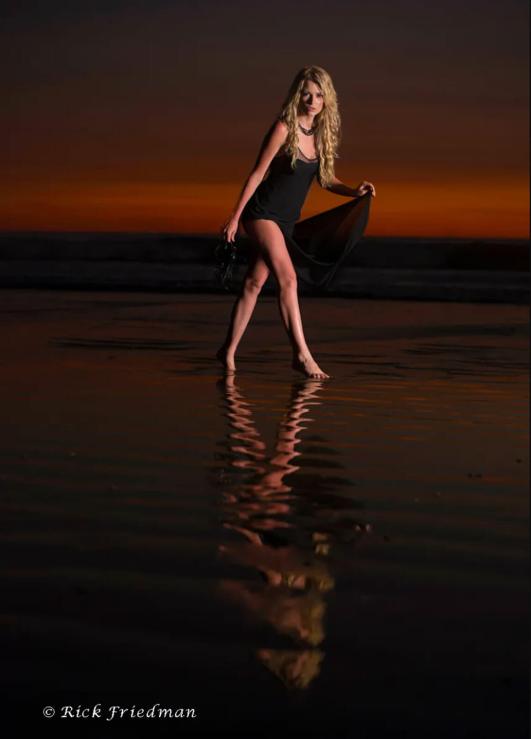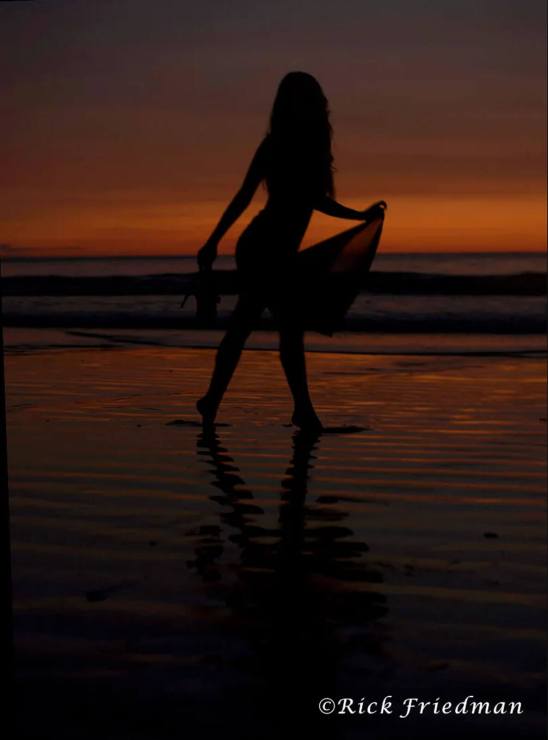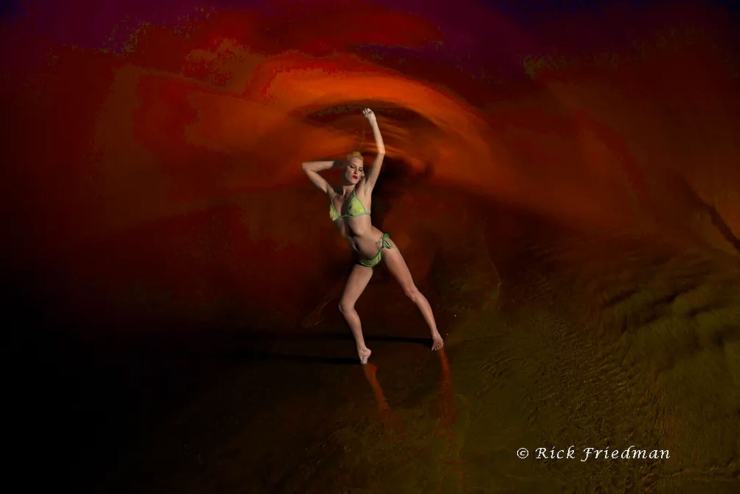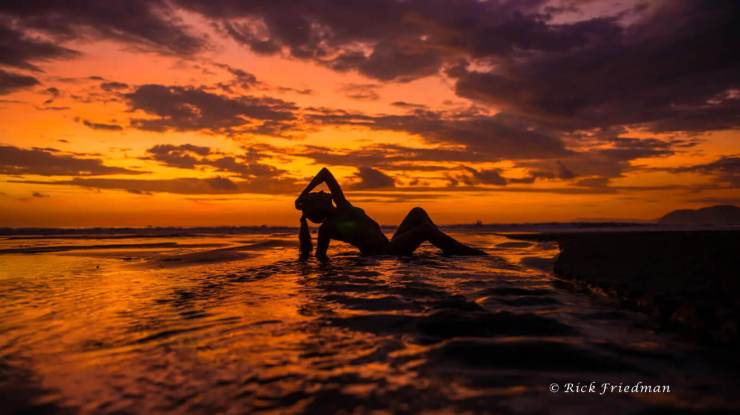Happy Summer! It’s time to get away from the computer or out of the darkroom and enjoy the beautiful weather and head to the beach!
Here are 3 tips on making great beach photographs. I shot these photographs at the end of the day, catching the very last bit of light, at the same location, yet achieving very different visual impacts. All of these photographs are shot without a tripod even though they are fairly long exposures.
Exposing for the last light of the day at the beach
Start by using the in-camera meter to read the light on the horizon. Make sure you are shooting in manual exposure mode. I underexpose my meter reading by 1 stop. Underexposing the ambient light gives you deeper and more intense colors. Alternatively, you can aim the camera meter well above the horizon and use that reading. My camera setting for this picture was ISO: 400, 1/5 second & F4. You can see the model is in silhouette. It was quite dark. I used the Hensel Porty, a 1200 watt/second battery-powered portable manual studio strobe with a Chimera 24″ beauty dish to light the model.
.mgl-tiles { display: none; } #mgl-gallery-634ec4798363b { margin: -5px; width: calc(100% + 10px); } #mgl-gallery-634ec4798363b .mgl-box { padding: 5px; } @media screen and (max-width: 768px) { #mgl-gallery-634ec4798363b { margin: -5px; width: calc(100% + 10px); } #mgl-gallery-634ec4798363b .mgl-box { padding: 5px; } } @media screen and (max-width: 460px) { #mgl-gallery-634ec4798363b { margin: -5px; width: calc(100% + 10px); } #mgl-gallery-634ec4798363b .mgl-box { padding: 5px; } }


For this set up you won’t need 1200w/s of power. Either the Dynalite Baja B4 (400 w/s) or its big brother the Baja B6 (600w/s) is a great alternative for a lot less money. You can also do this with a Speedlight although the recycle times will be a lot longer. I used a Sekonic L-478 flash meter to measure my strobe’s output. You want the same f/stop from the strobe as you had for the background before underexposing it one stop.
Take the flash reading by holding the meter very close to the model’s face aimed toward the strobe. I’ll quite often touch the back of the meter to the subject’s cheek to be certain it’s the right distance from the light. If the meter is held away from the model’s face and closer to the flash, the reading will be a higher f/stop as the meter is closer to the strobe than the model. She will be underexposed. Notice the reflection on the water is brought into the image by using the strobe. I used a 70-200 F2.8 Nikkor lens set at 70mm.
Spinning the horizon
Set your camera on manual exposure mode. Use your in-camera meter to read the ambient light on the background, which is the last light on the horizon in this photograph. My camera setting for the image is ISO:200, f4.5 at 1/2 second. The flash/beauty dish combo was held by another photographer since the tide was coming in and would knock over a light stand.
As before my strobe output was measured by using the Sekonic flash meter. In this situation, you get your background exposure by using your in-camera meter and reading your strobe output with a light meter. If you don’t have a light meter, you can fire test shots and look at the back of your camera. It may take several tests to get a good-looking exposure.

When I am looking at the screen on my camera, I use a Hoodman Compact HoodLoupe. This keeps any ambient light from hitting the screen. Doing this makes it a lot easier to see the result. It even magnifies the image. When I’m photographing, I use the HoodLoupe all the time, even in the studio.
During this exposure, I spun the camera clockwise. The 1/2 second exposure is short, so my spinning is quick, and the model is lit when the strobe fires. It freezes her movement. The light from the background spins around the model. My shutter is open for 1/2 of a second burning the twirling background into the image.

Enjoy the light at the beach
I am a lighting guy! I use light, I teach light, and I love light! With this amazing sky, shooting the model in silhouette made a stunning shot. Use your in-camera meter to read the sky above your head. She will automatically become a silhouette.
The low camera angle makes the foreground pull the viewer into the image while the colors in the sky reflect in the waves and create her silhouette. My camera setting for this image is ISO:200, 1/100 sec, f3.5.
I love photographing at dusk! Starting during the late afternoon golden hour and keep working through the blue hour when the sky becomes a deep royal blue. I keep shooting until we reach what I call “f nothing.” That’s when the sky is totally black.
These photographs are from a Location Lighting Workshop I taught with my friend Rolando Gomez in Jaco Beach, Costa Rica.
To see more of my work and upcoming workshop schedule please check out www.rickfriedman.com
Equipment used:
Nikon D810
Nikon 70-200 f2.8 lens
Nikon 17-35 f2.8 lens
Sekonic L-478 Lightmeter
Hensel Porty Strobe
Chimera Beauty Dish
ThinkTank camera cases
Hoodman Loupe
Tell your story with the second annual Visual Storytelling Conference!
Experience four days of interactive, online training sessions featuring a range of educational content with experienced photographers and content creators. This free event kicks off with a series of technical boot camps to build essential skills, followed by live, online sessions on photography, video, business and social media. Join live from March 10-13, 2022!
